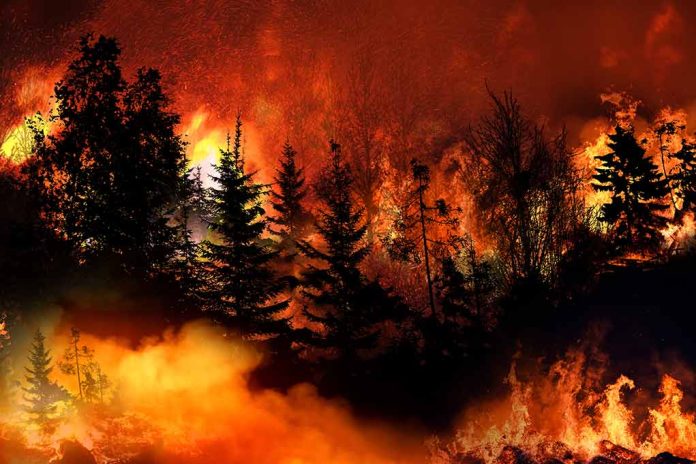
California’s wildfires take a sinister turn as individuals reportedly exacerbate blazes with gasoline.
At a Glance
- People observed throwing gasoline to fuel California wildfires
- Information shared via tweet by @iAnonPatriot
- Video or image of the incident included in the tweet
- Arson allegations spark calls for stricter legal and community responses
Alarming Reports of Deliberate Fire Escalation
A disturbing report emerged of individuals deliberately exacerbating wildfires in California. The information, shared by Twitter user @iAnonPatriot, included visual evidence of people allegedly throwing gasoline to fuel the fires. This shocking development has raised serious concerns about the potential for intentional acts to worsen an already critical wildfire situation in the state.
The alleged incident highlights a new and dangerous dimension to California’s ongoing struggle with wildfires. If confirmed, these actions represent a severe threat to public safety, property, and the environment, potentially turning natural disasters into criminal acts of arson.
Musk weighs in on California wildfires, blaming local bureaucracy. Wildfires rage in California annually & are not a freak event – suggesting a possible systemic failure of prevention. pic.twitter.com/J9Rb4tfJOf
— RT (@RT_com) January 8, 2025
Legal Implications and Community Response
The reported use of gasoline to intensify wildfires falls squarely within the definition of arson, a serious criminal offense. Arson is typically classified as the intentional and malicious burning of property, and when applied to wildfires, the consequences can be catastrophic.
“People were spotted throwing gasoline to fuel the fires in California…” reported American AF @iAnonPatriot. This alarming report has prompted calls for increased vigilance and stricter enforcement of existing arson laws. Community leaders and law enforcement agencies are likely to push for enhanced penalties for those found guilty of deliberately worsening wildfires, given the enormous risks to life and property.
Challenges in Wildfire Management and Prevention
The alleged use of gasoline to fuel wildfires presents a new challenge for fire management authorities. Traditional fire prevention measures may not be sufficient to address deliberate acts of arson, necessitating a reevaluation of current strategies. Fire departments and forest management agencies may need to collaborate more closely with law enforcement to develop comprehensive approaches to wildfire prevention and arson deterrence.
Communities in fire-prone areas are now faced with the additional task of remaining vigilant not just for natural fire hazards, but also for potential arsonists. This may lead to increased community patrols, the implementation of surveillance systems in high-risk areas, and public awareness campaigns to educate residents about the signs of suspicious activity related to wildfire arson.
The Role of Social Media in Wildfire Reporting
The incident’s reporting via social media underscores the growing importance of platforms like Twitter in disseminating critical information during emergencies.
As California continues to grapple with the threat of wildfires, the alleged gasoline-fueled arson serves as a stark reminder of the complex challenges facing the state. It calls for a multifaceted response involving law enforcement, fire management authorities, and community engagement to protect lives, property, and the natural environment from both natural and man-made fire hazards.
Sources:
WATCH: People were spotted throwing gasoline to fuel the fires in California













